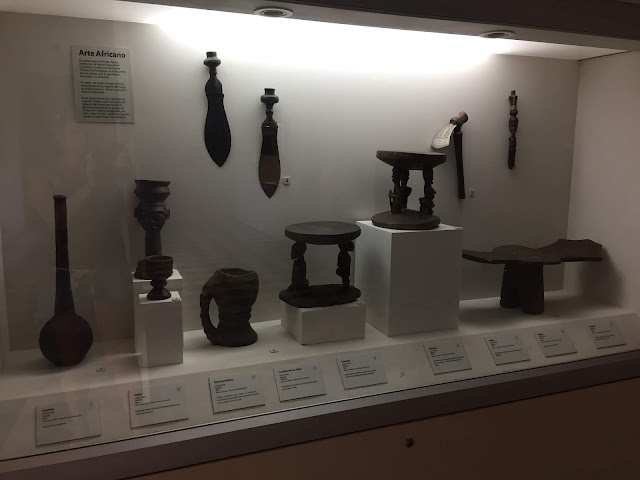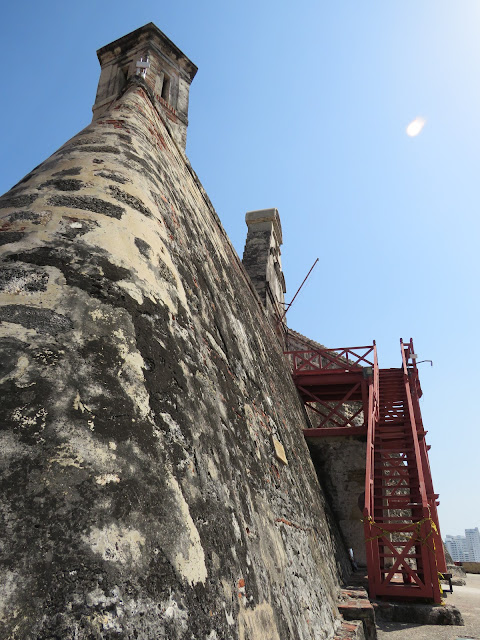Our hotel, Casa Mary, near the Park Del Centario, was in a great location among the old streets of the old city. The streets themselves are a wonder. They are awash in colour had kept their old charm. Some were being restored and I am not
sure how old they were but the buildings really did have the classic
Spanish style to them. Many buildings were lined with massive bougainvilleas.
 |
| Cartegena, Colombia |
 |
| Cartegena, Colombia |
 |
| Cartegena, Colombia |
 |
| Cartegena, Colombia |
Club Havana one of the big famous salsa clubs in the city was also right down the street from us but they have an expensive cover and drinks so I'd recommend just going to one of the many other places around.
 |
| Cartegena, Colombia |
Street art was also popular and some of the murals were incredible. Obviously the bird one was my favorite...
 |
| Cartegena, Colombia |
The hotel had a lovely terrace and that is where they served the complimentary breakfast.
From the hotel you can see a few birds including Black Vultures, Bananaquit, Eared Dove, Common Ground Dove, Rock Pigeon, Rufous-tailed Hummingbird, Brown Pelican and Magnificat Frigatebird.
 |
| Black Vulture |
 |
| Common Ground Dove |
Park Del Centario is a fairly big park with statues, fountains and trees. It's definitely pretty busy during the day with people taking breaks in the shade. Near the Park Del Centario there was a small market that sold souvenirs. The souvenirs are pretty much the same as the ones they sell in the stores but you can get a better price here if you can find what you want.
 |
| Park Del Centario, Cartagena |
One part of the walled city is a sweets market and you can find freshly made sweets that look like macaroons in all different flavours.
 |
| Cartegena, Colombia |
At night street performers come out nearby the park at the edge of the walled city. There is music and dancing.
 |
| Cartegena, Colombia |
 |
| Cartegena, Colombia |
Emeralds shops are found throughout the city and if you're really interested there are a few reputable stores including the Emerald Museum, but frankly the stores in Cartagena are touristy and if you're really interested in finding nice Colombian emeralds you should shop in Bogota. They really do make everything out of emeralds though...
 |
| Colombian emerald penis necklace |
The Gold Museum was closed when we visited but they did have a small exhibit set up in place of the full museum. Even though it was small it was incredible. Huge pieces of gold made into ornaments. Some with such tiny intricate designs.
 |
| Cartagena Gold Museum |
 |
| Cartagena Gold Museum |
There was one thing I absolutely loved and looked all over the city for in the replica shops. This little frog just stole my heart. Frogs were symbols of fertility, not just in the typical way you think of it as making lots of babies but more fertility of the land itself. They were spirits of rain and water and their symbols were used in rituals to call the rains.
 |
| Cartagena Gold Museum |
Bolivar Plaza is a small park near a lot of the tourist attractions (church, Palace of the Spanish Inquisition, gold museum, emerald museum and churches). There were a lot of pigeons in the park and that drew in hawks and caracaras. The Sea Almond trees drew in the Chestnut-fronted Macaws and we had a great view of them from the balcony at the Palace of the Inquisition.
 |
| Roadside Hawk |
 |
| Chestnut-fronted Macaw |
The Palace of the Inquisition was not really what I expected. I have pictures palaces pretty much like castles in other countries but this palace was just a set of four houses all built together. Keep in mind these four houses were mansions for sure but still didn't really fit palace in my mind. That being said still well worth the visit.
 |
| Cartagena Palace of the Inquisition |
 |
| Cartagena Palace of the Inquisition |
 |
| Cartagena Palace of the Inquisition |
Walking around the building I was a bit surprised that there wasn't much information at all about the inquisition itself and there was no explanation about the historical layout of the houses. I was curious to learn about what happened where. Did the people living there just give up their houses for this or were they kicked out? Who were they?
 |
| Cartagena Palace of the Inquisition |
 |
| Cartagena Palace of the Inquisition |
One of the most interesting things I saw was the water cistern. It never really occured to me that living on the ocean they would have very little access to fresh water except from the rivers higher up (pain to get that down to the city) or from rain. This collects all the rainfall from the roofs and stores it in a big concrete box. You can access the box by a staircase down into it or climb up the the hole and draw it out like a typical well.
 |
| Cartagena Palace of the Inquisition |
 |
| Cartagena Palace of the Inquisition |
 |
| Cartagena Palace of the Inquisition |
If I had to take a guess the courtyard is where the executions actually took place because they have a noose and guillotine set up here.
 |
| Cartagena Palace of the Inquisition |
 |
| Cartagena Palace of the Inquisition |
 |
| Cartagena Palace of the Inquisition |
 |
| Cartagena Palace of the Inquisition |
The upper floors had history of Cartagena and local art exhibits. I think they did very well mixing in the local history but I was a bit disapointed with the art exhibit. Not to say it wasn't good art but the artist had actually painted on the old walls of the building and I found that quite disappointing and discouraging. I would have very much enjoyed the exhibit except for the fact I felt like it was out of place and took away from the history of the place.
 |
| Cartagena Palace of the Inquisition |
 |
| Cartagena Palace of the Inquisition |
 |
| Cartagena Palace of the Inquisition |
 |
| Cartagena Palace of the Inquisition |
 |
| Cartagena Palace of the Inquisition |
 |
| Cartagena Palace of the Inquisition |
Castillo de San Felipe de Barajas is a must see for visiting Cartagena. It is completely iconic in the city and I have never seen such a massive fortress. It completely dominates San Lazaro hill overlooking the bay and city of Cartagena. The fortress was built to defend the city from terrestrial attacks and doesn't offer much support to the sea. Other smaller forts were built on the edge of the bay to do that.
 |
| Castillo de San Felipe de Barajas |
 |
| Castillo de San Felipe de Barajas |
 |
| Castillo de San Felipe de Barajas |
The fortress is built into multiple sections that all watch over each
other so that they are well protected. It is known as the largest and most impregnable fortress ever built by the Spanish in the Americas. BUT it did get taken over by the
French once but that was before it was completely finished and then by the Spanish when Colombia was fighting for independence. I guess they had the designs and strategy already so it's almost cheating.
 |
| Castillo de San Felipe de Barajas |
The oldest section is on the very peak of the hill and the only entrance was a wooded staircase that they would burn if under enemy attack. In a similar fashion other sections of the fort had bridges that could be destroyed to trap an enemy or prevent them from accessing the other section easily.
 |
| Castillo de San Felipe de Barajas |
 |
| Castillo de San Felipe de Barajas |
The fortress was built in the 1600s but underwent rebuilding and updating of the defenses many times over the course of history.
 |
| Castillo de San Felipe de Barajas |
 |
| Castillo de San Felipe de Barajas |
Now the city is surrounding the fort, but historically no cannons were pointed at the city in case the fort was overrun and attackers tried to use cannons against the city.
 |
| Castillo de San Felipe de Barajas |
There were LOTS of cannons...
 |
| Castillo de San Felipe de Barajas |
 |
| Castillo de San Felipe de Barajas |
 |
| Castillo de San Felipe de Barajas |
We rented a audio guide to the fort, which was VERY worth it. It had a tonne of information in it and was incredibly interesting. The tours you see walking around are in hoards so it was much preferable to go at your own pace and hear just as much if not more information as you explore all the nooks and crannies of the fort. In many places there were displays with old photos or information (also in English) but these were just snippets compared to the guide we had.
 |
| Castillo de San Felipe de Barajas |
 |
| Castillo de San Felipe de Barajas |
The fort also had multiple areas for storing water collected from the rain runoff and directed into big concrete cisterns. One was really massive and the other in the oldest part of the fort was still large but not quite as impressive.
 |
| Castillo de San Felipe de Barajas |
 |
| Castillo de San Felipe de Barajas |
The tunnel network under the fort is cut into the hill and extremely extensive. Little nooks held gunpowder and was where there would have been beds for the soldiers.
 |
| Castillo de San Felipe de Barajas |
 |
| Castillo de San Felipe de Barajas |
The city actually had more birds than expected and little patches on mangroves on the edge of the water were brimming with birds every evening. In particular many cormorants, egrets, herons, vultures, grackles and hundreds of Brown-throated Parakeets.
 |
| Brown-throated Parakeet |
 |
| Great Egret |
 |
| Cartagena |
 |
| Brown-throated Parakeet |
 |
| Brown-throated Parakeet |
 |
| Cartagena |
The last night I was in Cartagena was the night of the super moon and eclipse. I didn't stay away until 4am to see it transition because I had an early morning the next day with lots of flights but it was spectacular to see it rise over the castle.
 |
| Castillo de San Felipe de Barajas |
 |
| Super moon |
Like most place street food is always some of the best food and right down the street we had an arepas place that was always busy. It was well worth the wait and pretty much turned into a party on the street outside of the shop window with everyone drinking while they waited and music playing.
Another iconic thing in Caratagena are the numerous statues. Most are famous people and my favorite was the Monument of Indian Catalina. After being abducted and enslaved by a Spanish conqueror she learned Spanish. During her enslavement her people, the Calamari, were annihilated. Twenty odd year later she later acted as an interpreter and intermediary with the indigenous people during the Spanish conquest of Colombia and ended conflicts.
 |
| Monument of Indian Catalina |
 |
| Monument of Indian Catalina |

































































